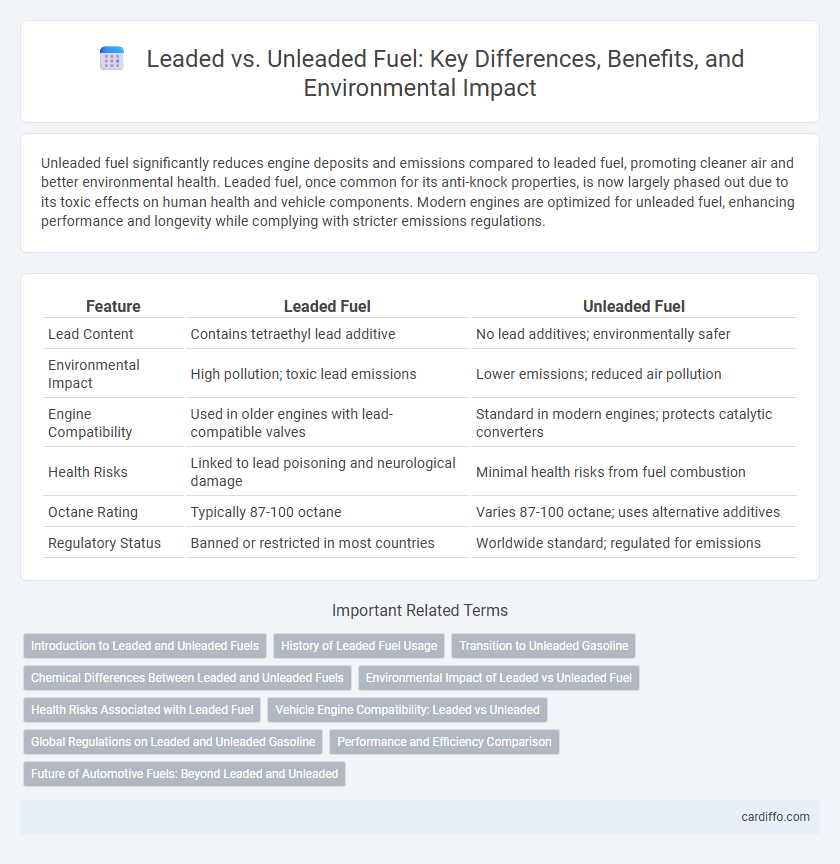Unleaded fuel significantly reduces engine deposits and emissions compared to leaded fuel, promoting cleaner air and better environmental health. Leaded fuel, once common for its anti-knock properties, is now largely phased out due to its toxic effects on human health and vehicle components. Modern engines are optimized for unleaded fuel, enhancing performance and longevity while complying with stricter emissions regulations.
Table of Comparison
| Feature | Leaded Fuel | Unleaded Fuel |
|---|---|---|
| Lead Content | Contains tetraethyl lead additive | No lead additives; environmentally safer |
| Environmental Impact | High pollution; toxic lead emissions | Lower emissions; reduced air pollution |
| Engine Compatibility | Used in older engines with lead-compatible valves | Standard in modern engines; protects catalytic converters |
| Health Risks | Linked to lead poisoning and neurological damage | Minimal health risks from fuel combustion |
| Octane Rating | Typically 87-100 octane | Varies 87-100 octane; uses alternative additives |
| Regulatory Status | Banned or restricted in most countries | Worldwide standard; regulated for emissions |
Introduction to Leaded and Unleaded Fuels
Leaded fuel contains tetraethyl lead, a compound once added to gasoline to improve engine performance and reduce knocking but has been largely phased out due to its toxic effects on health and the environment. Unleaded fuel, now the standard worldwide, eliminates lead additives, promoting cleaner combustion and reducing harmful emissions. The shift from leaded to unleaded fuels represents a critical advancement in automotive technology and environmental regulation.
History of Leaded Fuel Usage
Leaded fuel, introduced in the 1920s with tetraethyl lead as an anti-knock agent, significantly improved engine performance but caused widespread environmental lead contamination. Its widespread adoption peaked mid-20th century before health concerns and regulatory actions, such as the U.S. Clean Air Act amendments in the 1970s, initiated a global phase-out. By the early 2000s, most countries had transitioned to unleaded fuel to reduce lead poisoning and environmental hazards while maintaining engine efficiency with alternative additives.
Transition to Unleaded Gasoline
The transition to unleaded gasoline significantly reduced harmful emissions, improving air quality and public health worldwide. Unleaded fuel eliminates the toxic lead additives previously used to enhance engine performance, aligning with stricter environmental regulations. This shift supports modern catalytic converters, essential for minimizing pollutants and complying with global emission standards.
Chemical Differences Between Leaded and Unleaded Fuels
Leaded fuel contains tetraethyl lead, a compound added to improve engine performance by increasing octane rating and reducing knocking. Unleaded fuel lacks this lead additive, relying on alternative compounds like ethanol or MTBE to enhance combustion quality. The chemical difference primarily affects emissions, with leaded fuels releasing harmful lead particles that contribute to environmental pollution and health risks.
Environmental Impact of Leaded vs Unleaded Fuel
Leaded fuel releases toxic lead compounds into the atmosphere, causing severe air and soil pollution that endangers human health and wildlife. Unleaded fuel significantly reduces these harmful emissions, promoting cleaner air and decreasing the risk of neurological damage in both children and adults. Transitioning to unleaded fuel is essential for minimizing environmental contamination and supporting sustainable ecosystems.
Health Risks Associated with Leaded Fuel
Leaded fuel releases toxic lead particles into the air, which can cause severe neurological damage, especially in children, leading to cognitive impairments and developmental delays. Prolonged exposure to leaded fuel emissions increases risks of cardiovascular diseases, kidney damage, and reproductive issues in adults. Regulatory actions targeting the phase-out of leaded gasoline have significantly reduced these health hazards globally.
Vehicle Engine Compatibility: Leaded vs Unleaded
Leaded fuel contains tetraethyl lead additives that protect older vehicle engines from knocking and wear, whereas unleaded fuel is formulated for modern engines with advanced emission control systems like catalytic converters. Using leaded fuel in vehicles designed for unleaded fuel damages catalytic converters and increases harmful emissions, while unleaded fuel in older engines may cause valve seat recession without lead-based lubrication. Compatibility hinges on engine design and emission regulations, with most contemporary vehicles requiring unleaded fuel to ensure optimal performance and environmental compliance.
Global Regulations on Leaded and Unleaded Gasoline
Global regulations have progressively phased out leaded gasoline due to its severe environmental and health impacts, with the United Nations Environment Programme supporting initiatives that promote unleaded alternatives. Countries implementing strict emission standards have mandated the exclusive use of unleaded gasoline, significantly reducing atmospheric lead pollution and associated cardiovascular and neurological health risks. Current global policies emphasize the adoption of unleaded fuels alongside advancements in catalytic converter technology to meet increasingly stringent air quality regulations and sustainability goals.
Performance and Efficiency Comparison
Unleaded fuel enhances engine performance by reducing carbon deposits and improving combustion efficiency, resulting in smoother acceleration and better fuel economy. Leaded fuel, historically used to boost octane levels, increases engine knocking resistance but contributes to harmful emissions and decreased long-term engine health. Modern engines optimized for unleaded fuel achieve higher efficiency and lower maintenance costs compared to older models relying on leaded gasoline.
Future of Automotive Fuels: Beyond Leaded and Unleaded
The future of automotive fuels is shifting toward sustainable alternatives such as electric, hydrogen, and biofuels, moving beyond traditional leaded and unleaded gasoline. Advances in fuel cell technology and battery efficiency are driving zero-emission vehicles, reducing reliance on internal combustion engines altogether. Regulatory policies worldwide are accelerating this transition by phasing out leaded and unleaded fuels to meet stringent environmental standards.
Leaded vs Unleaded Infographic

 cardiffo.com
cardiffo.com